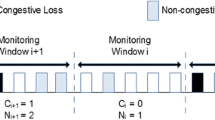Abstract
Loss Differentiation Algorithms (LDA) are currently used to determine the cause of packet losses with an aim of improving TCP performance over wireless networks. In this work, we propose a cross-layer solution using two complementary LDA schemes in order to classify the loss origin on an 802.11 link and then to react consequently. The first LDA scheme, acting at the MAC layer, allows differentiating losses due to signal failure caused by displacement or by noise from other loss types. Moreover, in the case of a signal failure, this scheme adapts the behavior of the MAC layer in order to avoid a costly end-to-end TCP resolution. The objective of the second LDA scheme, which acts at the TCP layer, is to distinguish between losses due to interferences and those due to congestions, then accordingly adapt the TCP behavior. We finally demonstrate, through simulation, the efficiency of each LDA scheme as well as the whole cross-layer solution.
Similar content being viewed by others
References
IEEE. (1999). IEEE 802.11 WG, part 11: Wireless LAN Medium Access Control (MAC) and Physical Layer (PHY) specifications (Standard).
IEEE. (2003). IEEE 802.11g WG, part 11-amendment 4: Further higher-speed physical layer extension in the 2.4 GHz Band.
Bottigliengo, M., Casetti, C., Chiasserini, C.-F., & Meo, M. (2004). IEEE INFOCOM 2004, Hong Kong, 7–11 March, 2004.
Chockalingam, A., Zorzi, M., & Tralli, V. (1999). In IEEE ICC 1999.
Mascolo, S., Sanadidi, M. Y., Casetti, C., Gerla, M., & Wang, R. (2002). TCP westwood: End-to-end congestion control for wired/wireless networks. Wireless Networks Journal.
Xu, K., Tian, Y., & Ansari, N. (2004). In IEEE JSAC, May 2004.
Cen, S., Cosman, P. C., & Voelker, G. M. (2003). End-to-end differentiation of congestion and wireless losses. IEEE/ACM Transactions on Networking (TON).
Bregni, S., Caratti, D., & Martignon, F. (2003). In Globecom 2003.
Balakrishnan, H., & Katz, R. H. (1998). In Proceeding of IEEE Globecom.
Ng, C. H., Chow, J., & Trajkovic, L. (2002). In Opnetwork 2002.
Lohier, S., Ghamri Doudane, Y., & Pujolle, G. (2005). In Proceeding of IEEE ASWN 2005.
The Network Simulator—NS-2. http://www.isi.edu/nsnam/ns/.
Ni, Q., Turletti, T., & Fu, W. (2002). In WWIC 2002.
Biaz, S., & Vaidya, N. H. (1998). In Proceedings of IEEE 7th international conference on computer.
Barman, D., & Matta, I. (2002). Effectiveness of loss labeling in improving TCP performance in wired/wireless networks (Technical report). Boston University.
Author information
Authors and Affiliations
Corresponding author
Rights and permissions
About this article
Cite this article
Lohier, S., Doudane, Y.G. & Pujolle, G. Cross-layer loss differentiation algorithms to improve TCP performance in WLANs. Telecommun Syst 36, 61–72 (2007). https://doi.org/10.1007/s11235-007-9054-0
Published:
Issue Date:
DOI: https://doi.org/10.1007/s11235-007-9054-0




